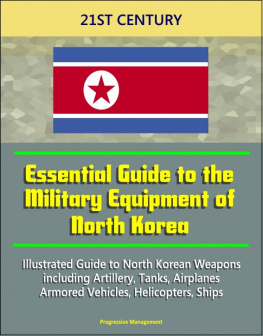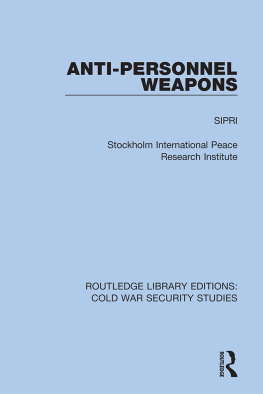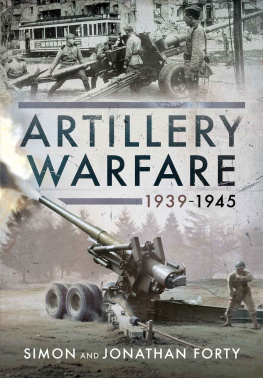A Greenhill Book

First published in Great Britain in 2001 by
Greenhill Books, Lionel Leventhal Limited
www.greenhillbooks.com
This edition published in 2014
by Frontline Books

an imprint of
Pen & Sword Books Ltd
47 Church Street
Barnsley, South Yorkshire
S70 2AS
Copyright Ian V. Hogg, 2001
The right of Ian V. Hogg to be identified as the author
of this work has been asserted by him in accordance with the
Copyright, Designs and Patents Act 1988
ISBN: 978-1-84832-726-9
PDF ISBN: 978-1-47389-703-8
EPUB ISBN: 978-1-47389-702-1
PRC ISBN: 978-1-47389-701-4
All rights reserved. No part of this publication may be reproduced, stored in or introduced into a retrieval system, or transmitted, in any form, or by any means (electronic, mechanical, photocopying, recording or otherwise) without the prior written permission of the publisher. Any person who does any unauthorized act in relation to this publication may be liable to criminal prosecution and civil claims for damages.
CIP data records for this title are available from the British Library
For more information on our books, please visit
or write to us at the above address.
Printed and bound in India by Replika Press Pvt. Ltd.
CONTENTS
INTRODUCTION
One of the things about the American Army of 19415 which impressed British soldiers was its profligacy with paper instructional paper, that is. I have before me the British Armys instructional pamphlet on the Lewis machine gun; it is 22 pages long and illustrated with a handful of amateurish line drawings. I also have before me the U.S. Field Manual 2315 on the Browning Automatic Rifle, more or less the American equivalent of the Lewis gun; it is of 208 close-printed pages illustrated with line drawings, diagrams and photographs. When I had a Jeep, it came with a drivers manual that must have been 200 pages long and covered every aspect of maintenance and operation; when I had a Morris gun tractor I was given a Guide to the Task System, a generalised 15-page pamphlet which detailed the orderly routine by which vehicle maintenance had to be done any vehicle, from a tank to a motorized lawnmower. The fact that this particular Morris had the accelerator between the clutch and brake pedals was something I had to find out for myself, the hard way.
Soldiers are a curious lot; they always want to know a bit more about what they are doing, and they are always curious about what people with other cap or collar badges are up to. But in European armies such curiosity was frowned upon; why do you, a field gunner, wish to know what weapons arm the coast defenses? You must be a spy. In the U.S. Army, on the other hand, such curiosity was welcomed; it showed that the man was taking an interest in the big picture and it indicated a willingness to cooperate with other arms of the services which was not, in the past, readily apparent.
And so, in order to satisfy this thirst for knowledge, and, if the truth be known, to boost morale by revealing as much as could safely be revealed about the nations armaments, various military agencies began producing compendia or catalogues to fill in the spaces which the official War Department manuals failed to reach. The Ordnance School at Aberdeen Proving Ground appears to have been among the first and most effective of these agencies, producing a six-volume ammunition encyclopedia, a two-volume set on coast artillery equipment, and useful volumes on sights, motor vehicles and similar subjects. And doubtless the Artillery, Armor, Transportation and other schools did likewise.
This was all very well in 19402 when the army was expanding faster than the distribution of official pamphlets could cope, but once the initial expansion was over some order had to be laid upon the scene, if only to make sure everybody was singing the same song to the same tune; it was no use TM 9-2005 Ordnance Material, General: Vol 4; Railway and Seacoast Artillery saying that the 12in Railway Mortar M1890 on Carriage M1 weighed 176,800 pounds when TM 4-210 Coast Artillery Weapons and Materiel said that it weighed 176,000 pounds. Sooner or later somebody would notice and questions would be asked. Moreover the amount and diversity of equipment being produced for the army needed to be properly catalogued for the benefit of staff officers and planners so that they could see whether there was a particular piece of equipment that would fill a need which had suddenly appeared, or whether they would have to go to some agency and have a new device designed and produced. (A point of view which, it seems, was lost sight of somewhere in the 1960s and led to the parallel development of similar equipment by all three services and the waste of large sums of money but thats another story.)
As a result of this sort of thinking, the Ordnance Department set about the production of a master catalogue which would cover in detail every piece of equipment, even the most modern for which reason it was graded Confidential. It was a luxurious production, on expensive, coated paper, supplied in loose-leaf form in a series of ring binders, and kept up to date by frequent amendments and issues of new pages. Blocks of pages were allocated to specific groups of equipment; some groups were filled, others were not, which accounts for gaps in the pagination, and the system stuttered somewhat when equipment for which small provision had been made such as rockets began to appear in bulk and had to be fitted in where it could. It was an ambitious programme, and it took time to get going; and before it could be completed, second thoughts were being had. There was, for example, no good reason to fill a Confidential manual with details of things like motor-scooters or binoculars, which were commercial products bought off the shelf. More so when the War Department, now beginning to catch up on its original responsibilities, began producing its own series of catalogues such as TM9-2800 Standard Military Motor Vehicles of 1 September 1943, catalogues which were perhaps to a lesser standard of erudition but certainly to a lesser standard of production and hence cheaper and hence given far greater distribution. And they were simply Restricted documents, making distribution even more generous.
Faced with these War Department volumes, the Ordnance Department production began to look superfluous. We have now no way of knowing, but long experience of the institutional military system leads me to suspect that the sub-department in charge of the Catalog saw the writing on the wall and began to wonder how they could continue to produce this Confidential series in the face of the Restricted competition. Somebody spotted the lifebelt and grabbed it: include the latest information on Enemy equipment! This had to be confidential you didnt want them to know what you knew about their stuff so it was the very thing to be included in this prestigious publication. And so two new sections appeared, German Equipment and Japanese Equipment, and were tacked on to the end of the final volume.
As the war entered its final year, the amount of enemy equipment in Allied hands, and the amount of information acquired about it, had reached such proportions that many other specialised volumes were being published on this subject. Most of them were graded Secret and therefore held much more detailed information than could be included in a Confidential document, and so the provision of enemy material information soon began to shrink. And by the summer of 1945 it seems that the whole project had come to a halt. I have never seen any formal notice of its termination, and it was not until many years later that I ever saw a complete volume of this series and then, eventually, the complete set.
Next page
















